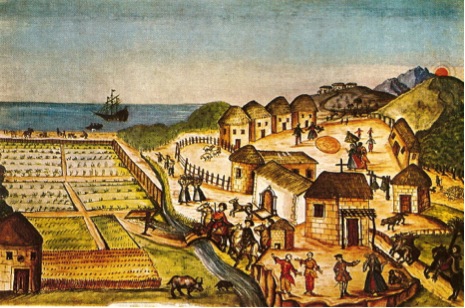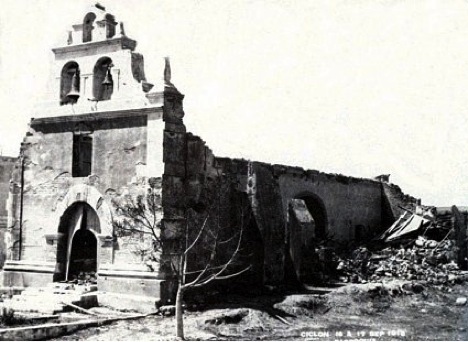
By David Kier
Co-author of ‘The Old Missions of Baja & Alta California, 1697-1834’
The 12th California mission was planned for the land of the Pericú and to provide support for the Manila galleons. The Jesuit Visitador General, Padre José de Echeverría chose Padre Nicolás Tamaral from the La Purísima mission to open the new mission. In March of 1730, Echeverría and Tamaral sailed south from Loreto to La Paz, along with several Spanish soldiers. Following an inspection of the mission at La Paz, they traveled south to the visita of Todos Santos, and mission of Santiago. A day’s journey south from Santiago, they found a suitable site on an estuary where a fresh water river reached the sea.
Two huts were constructed of palm leaves and reeds to serve as a chapel and a house for the padre. The Pericú did not appear in the numbers anticipated until after Echeverría and the soldiers left, two weeks later. Padre Tamaral was soon approached by the Indians, and was converting as many as 100 in a single day. In a letter from December 1730, Tamaral wrote to Echeverría that 823 had been baptized since the mission was founded.
Poor soil and swarms of mosquitoes forced Tamaral to move the mission further inland, to a place known as Añuití. A major issue the Jesuit had with converting the natives to Christianity was the habit of the men to have several wives. Padre Tamaral wrote of the issue to the mission’s benefactor, the Marqués de Villapuente on June 15, 1731. Tamaral describes how the wives compete we each other to gather the most food while their husband rests all day in the shade, with no need for him to work. Tamaral believes only by halting polygamy is there any hope to get some work performed by the lazy men! Pericú women outnumbered men, so polygamy was desired by them as well.
It became obvious that this change was not appreciated by the Pericú and the revolt of 1734 would cost the life of Tamaral and his fellow Jesuit, Padre Carranco at Santiago. The mission was destroyed and the Indians of different tribes united against the Jesuits and Spanish. The destroyed missions of Pilar de la Paz, Santiago, San José del Cabo and Santa Rosa (Todos Santos) would remain deserted while the Spanish organized a response. Unknowingly, in January 1735, the Manila galleon had anchored offshore from San José del Cabo to obtain supplies after their long voyage across the Pacific. Thirteen men who came ashore in a longboat were massacred. Some Pericú men canoed out and tried to take the galleon, but they were repulsed and the ship pulled up anchor and left for Acapulco.
A response to the uprising was carried out in February 1736 by Bernal de Huidobro, the governor of Sinaloa with forty soldiers. They labored for a year and a half to capture all hostile Indian leaders. A decision was made in 1736 to establish an independent military fort called the ‘Presidio of the South’, at San José del Cabo. Calm and rebuilding began in early 1737 when the mission was reestablished closer to the estuary and new presidio. Epidemics in 1742, 1744 and 1748 caused a drop in neophyte population to such a degree that in 1748 the mission of San José del Cabo was closed and became a visita of Santiago. A final location change for the church was made in 1753, to just north of the estuary.
On November 30, 1773, the newly appointed governor of California, Capitán Gaspar de Portolá and 25 armed soldiers landed on the beach at San José del Cabo to organize the surprise removal of all Jesuits from the peninsula. Padre Ignacio Tirsch made the ride south from his mission at Santiago as the first California Jesuit to greet Portolá, not aware of the orders he brought.
Following the Jesuit expulsion, it was decided to reopen the mission at San José del Cabo in 1768. In the few months the missions were without their padres, the neophytes were demoralized, and the Franciscans had to undo damage done by the Spanish soldiers that were in charge. The new Spanish inspector-general, José de Gálvez was determined to equalize populations at the missions and in September 1768 ordered 44 neophytes moved from San Javier to San José del Cabo. All but 3 died during an epidemic in 1769.
On May 12, 1773, eighteen Dominican priests arrived at Loreto to replace the Franciscans on the peninsula. The Franciscans would be in charge of the new region north of the peninsula then called Nueva (New) California, and the Dominicans would be operating the existing peninsula missions of Antigua (Old) California, as well as adding new missions in the north of the peninsula. In April 1795 the mission of Santiago was closed and its few remaining neophytes were moved to San José del Cabo. In 1799, a large adobe building was erected to replace the church destroyed in floods of 1793. The Indian population did increase to 200 in the year 1800.
The mission was sacked in 1822 when the English admiral Thomas Cochrane used Chilean ships to harass any remaining Spanish officials not yet surrendered to the new Mexican government. This was an act of piracy as the ships were made to appear as whaling vessels. Cochrane and the Chileans also pillaged the missions at Todos Santos and Loreto.
Mission services to native Californians ended about 1840, but Dominicans continued to be active at the church for several years for the new population arriving from the mainland. The last Dominican to serve at San José del Cabo was Fr. Gabriel Gonzalez. Fr. Gonzalez and Fr. Tomas Mansilla, the only other California Dominican, left the peninsula in February 1855.
David Kier is co-author of ‘The Old Missions of Baja & Alta California, 1697-1834’. The book is available for purchase HERE or at the DBTC offices (call 800-727-2252).





